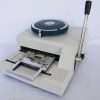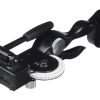Marking parts with serial numbers or labels often calls for a tool that works fast and gets it right every time. That’s where the Model 40B Numbering & Lettering Press from Short Order Products comes in. It’s a manually operated press that stamps clean, permanent characters into tags made of metal or plastic. So, how does it work? Let’s go over the details.
What Is the Model 40B Numbering & Lettering Press Used For?
The Model 40B is made for hand-stamping letters and numbers with accuracy. It’s perfect when you need clean, long-lasting marks on flat metal or plastic tags. Many industries rely on it for daily use.
You’ll often find it used for:
- Labeling tools and equipment
- Marking parts in manufacturing
- Creating ID tags for electrical panels
- Keeping track of inventory with serial numbers
- Stamping tags in military or aerospace settings
Main Parts of the Model 40B
To really understand how the Model 40B works, it helps to get familiar with its key parts. Each one plays a role in making sure your stamp comes out clean and accurate every time.
- Character wheel: This is where all the letters and numbers are stored. You rotate the wheel to select the character you want to mark.
- Selector dial: It helps you turn the wheel and line up the correct character with the stamping point.
- Character pointer: A small marker that shows which character is active. It keeps your selection clear and avoids mistakes.
- Tag holder: This flat base keeps your tag in place and in the right position while you press. It’s what helps the stamp land exactly where it should.
- Lever handle: Once everything’s set, you pull this handle to apply the pressure and make the mark. It’s smooth but firm.
- Depth adjustment knob: Need a deeper or lighter stamp? Just turn this knob to set how hard the press hits the surface.
- Stop bar or backstop: It holds the tag from the back, so it doesn’t move while you’re stamping.
- Slide rail or spacing guide: After stamping one character, this guide helps you shift the tag evenly for the next one.
- Mounting base: The bottom platform holds everything together. It keeps the machine in place while you use it, even when pressing harder materials.
Step-by-Step: How the Model 40B Works
Here’s a clear breakdown
1. Load the Tag
First, place your blank tag into the holder. It stays secure during stamping, so nothing shifts while you work.
2. Choose the Character
Turn the character wheel until the desired letter, number, or symbol lines up with the pointer. It clicks into place, so you know it’s set correctly.
3. Adjust the Depth (Optional)
If you’re working with a soft material, you may not need deep marks. Use the depth control knob to make it lighter or deeper, depending on your needs.
4. Press Down the Lever
Once your character is selected and everything’s in place, pull the handle down firmly. This pushes the character into the tag with clean, even pressure.
5. Move to the Next Spot
Slide the tag slightly to the left or right, depending on your setup, to line up the next spot. Then repeat the steps to add more characters.
What Materials Can It Mark?
The Model 40B works best with flat metal or plastic tags. Most users stamp:
- Aluminum
- Brass
- Stainless steel (lighter gauges)
- Vinyl or rigid plastic
Why Do People Prefer the Model 40B?
There’s a reason the Model 40B Numbering & Lettering Press has stayed popular for so many years. It’s simple, tough, and gets the job done.
No Electricity Needed
Unlike machines that rely on power or software, this press is fully manual, which means you can use it just about anywhere without needing electricity.
Compact Size
Its compact size makes it a good fit for any small workspace or bench. You don’t need a large setup.
Durable Parts
On top of that, it’s built from strong, long-lasting materials, so it holds up well even with daily use. Most users find that it needs very little upkeep.
Precise Alignment
Another reason people trust this model is the accuracy of the stamping. The characters come out clean and straight with hardly any adjusting.
Easy to Use
Best of all? You don’t need years of experience to use it. Even first-time users can get the hang of it after just a few tries.
Maintenance and Care
The Model 40B doesn’t need much maintenance, but a little care goes a long way. Keep the parts free of dust and debris. Occasionally check the alignment of the wheel and the tightness of the screws. Wipe it down after heavy use, and store it in a dry place. The character wheel can be replaced or customized as needed, and replacement parts are available through Short Order Products.
When Is the Model 40B a Good Choice?
This press is ideal when you need the following:
- Short runs (5 to 50 tags at a time)
- Custom or one-off markings
- Deep, readable characters
- Manual control over spacing and pressure
At Short Order Products, we make it easy for businesses, shops, and hands-on makers to get the right marking tools. With years of experience behind us, we offer equipment that’s simple, tough, and made to last, just like the Model 40B Numbering & Lettering Press.
Need help choosing the right tool? Get in touch with us today.
FAQs
1. Can I use the Model 40B on stainless steel tags?
Yes, but it works best on thinner stainless steel (under .030″).
2. How many characters are on the wheel?
Most wheels include 36 characters (A to Z and 0 to 9).
3. Does it need power or batteries?
No. The Model 40B is fully manual.
4. Can I stamp more than one line on a tag?
Yes, you can. Just reposition the tag to start a second row of text.
5. Can beginners use it?
Yes. After a few practice stamps, most people feel comfortable using it.
People Also Ask
What materials can the Model 40B stamp?
The Model 40B works well with flat metals like aluminum, brass, steel, and some plastics.
Can I adjust the spacing between characters?
Yes. You can control spacing by using a half‑stroke of the lever or adjusting the spacing pawl.
How heavy and portable is the Model 40B?
Weighing about 40 pounds, its cast‑iron frame is heavy-duty yet still easy to move.
Do I need training to use it?
Not at all. After a few minutes of practice, most people can produce neat, consistent stamps.








